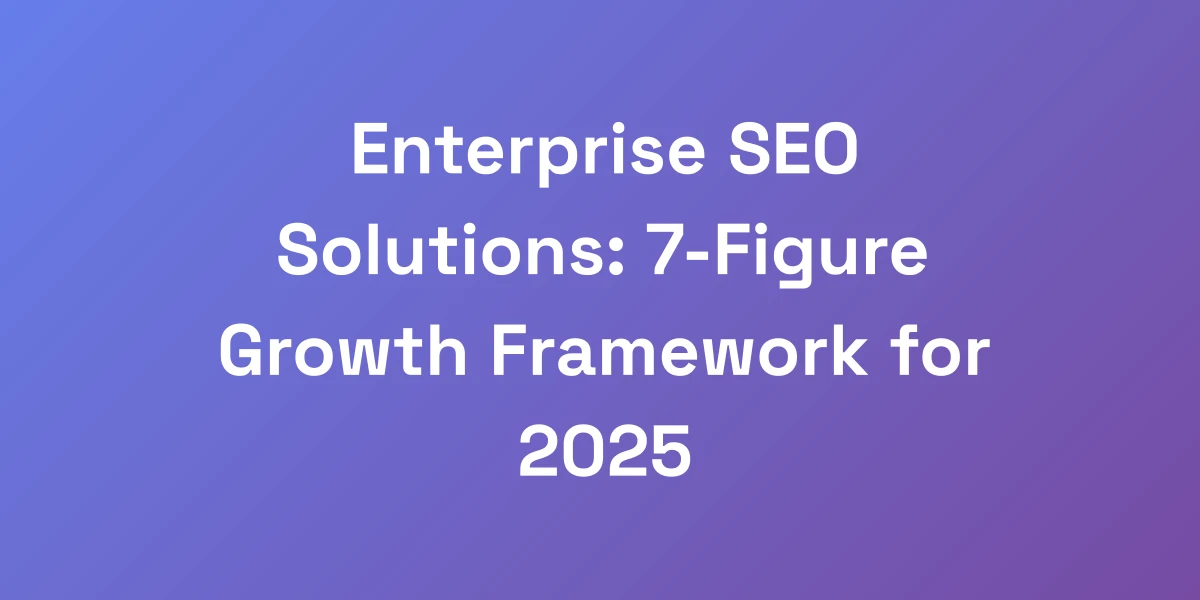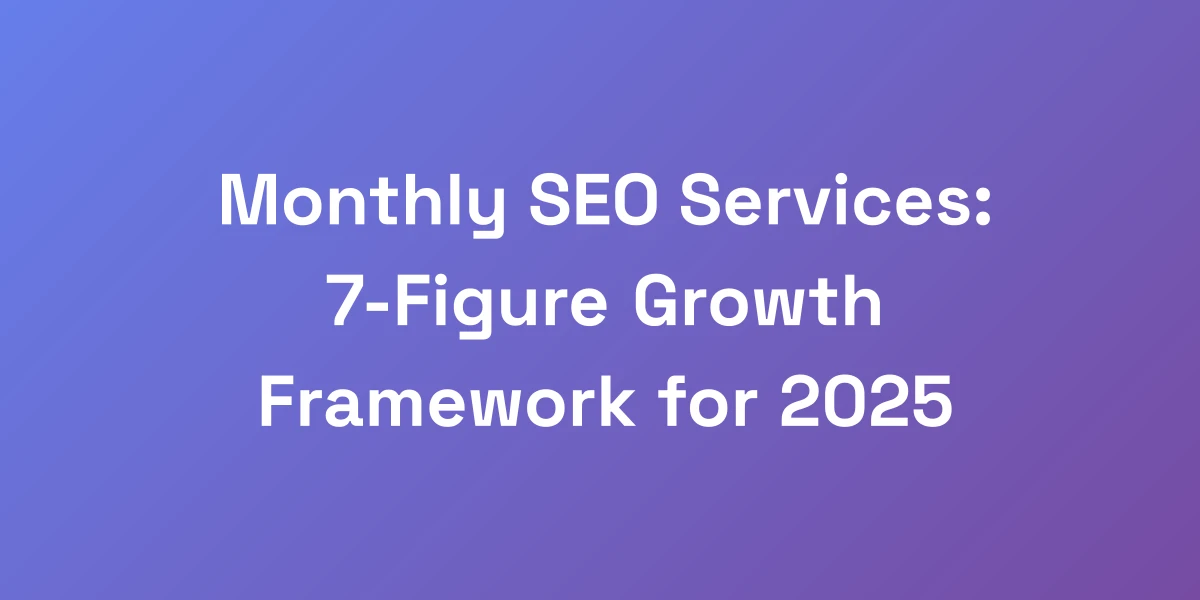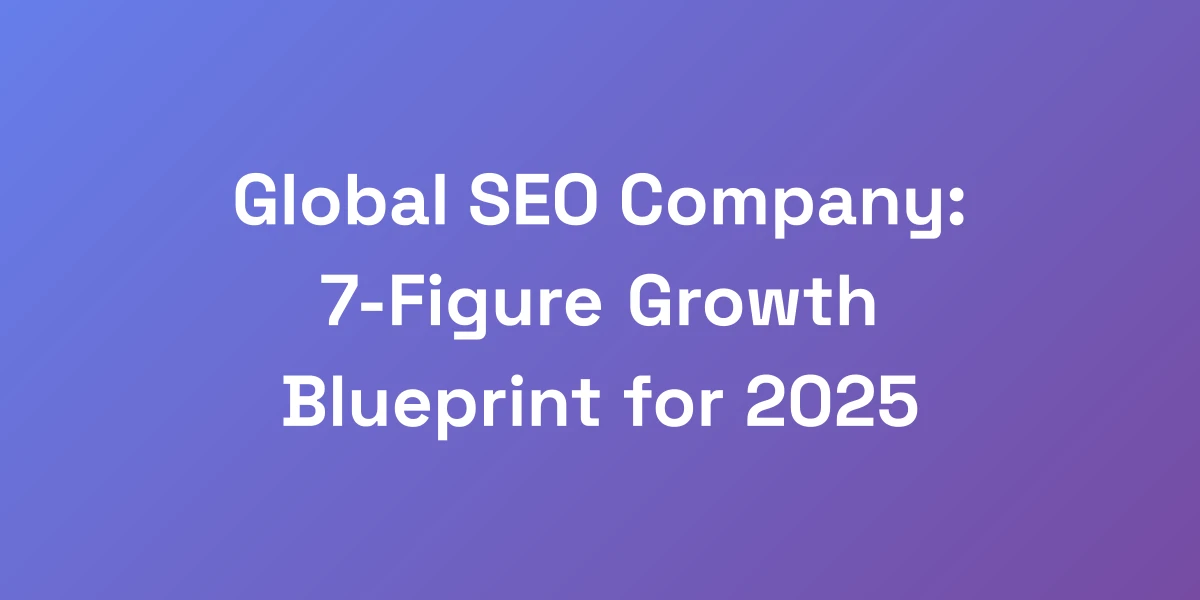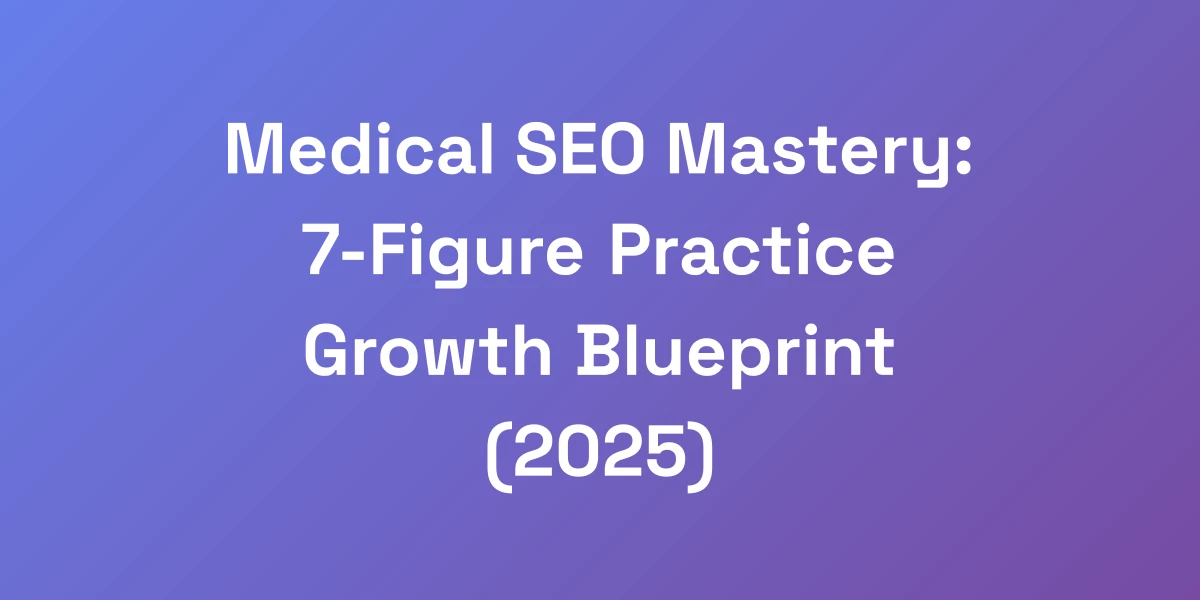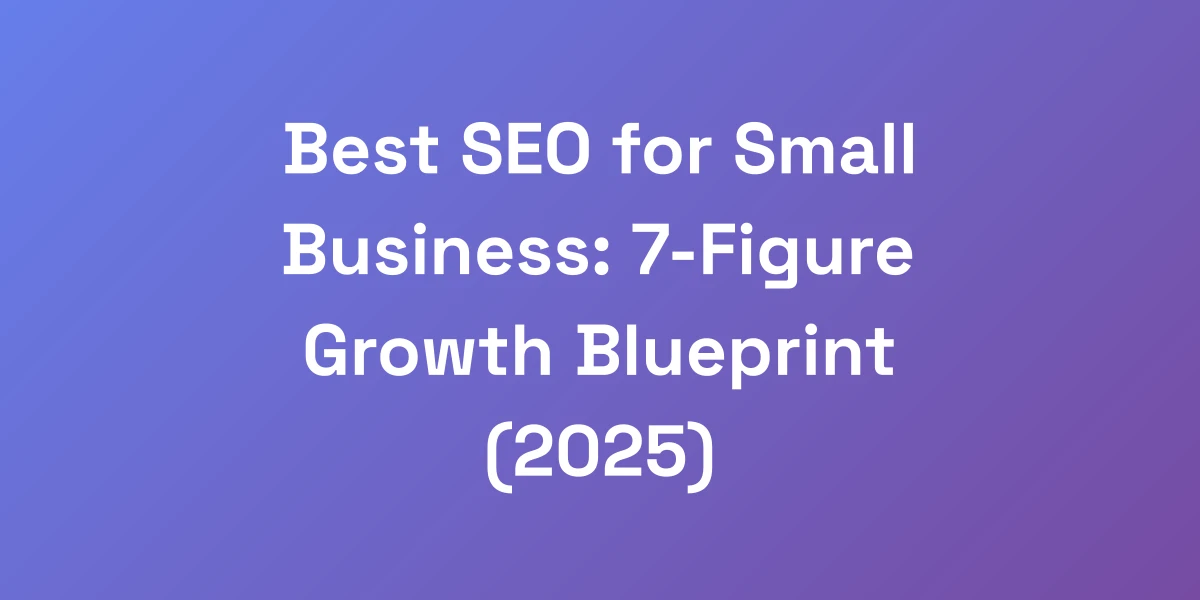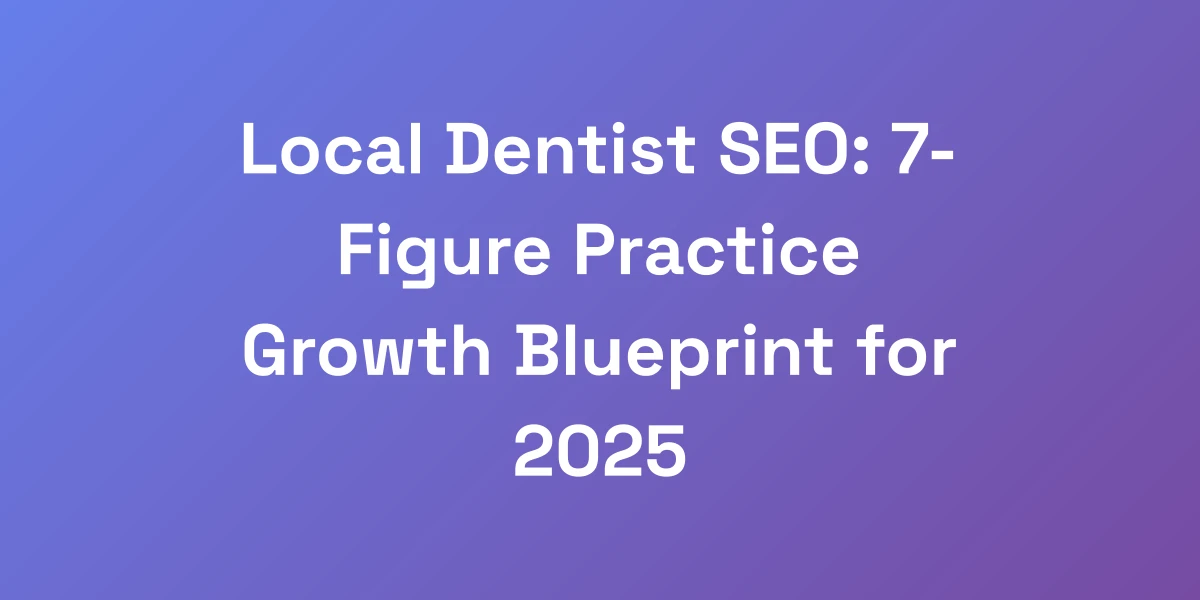
SaaS SEO Mastery: 7-Figure Growth Playbook for 2025
Mar 18, 2025 | By [email protected]
Introduction
Let’s get straight to the point: if you’re a SaaS company not maximizing your B2B SaaS SEO, you’re leaving serious money on the table.
We’ve seen it time and again—90% of SaaS companies are completely mismanaging their SEO strategies. Imagine pumping thousands into content creation, only to realize it’s pouring into a leaky bucket. Frustrating, right?
But here’s the kicker: your competitors aren’t playing it smart either. They’re stuck with outdated methods, fighting over the same keywords without a game plan. It’s a crowded battlefield out there.
Ready to flip the script? In this guide, we’re diving deep into the strategies that can dominate your niche and help you achieve 7-figure growth by 2025. Buckle up—this is the playbook you need.
The Hidden Gold Mine: Why SaaS Companies Are Leaving Millions on the Table with Poor SEO
Let me hit you with some truth: 90% of SaaS companies are absolutely butchering their SEO strategy. I’ve consulted for companies doing 8-figures in ARR, and they’re still making rookie mistakes that cost them millions in potential revenue.
Here’s the reality: your competitors are fighting for the same keywords, but they’re using outdated playbooks. In this guide, we’re going to show you exactly how to dominate your niche using the same strategies that helped our clients 10x their organic traffic in less than 12 months.
The Real Cost of Ignoring SEO in SaaS
Ignoring SEO isn’t just a missed opportunity—it’s a direct hit to your bottom line.
Consider this: B2B SaaS companies achieve an average ROI of 702% through SEO over three years. That’s not chump change.
- Revenue Loss: Without a strong SEO presence, you’re missing out on organic traffic that could convert into paying customers.
- Increased CAC: Relying on paid channels means higher Customer Acquisition Costs, sometimes up to 60% more than organic methods.
- Competitive Disadvantage: Competitors with robust SEO strategies are climbing the ranks, capturing your potential leads.
Can you afford to let competitors snag your audience while you play catch-up?
Why Traditional SEO Strategies Fail for SaaS
Traditional SEO is like using a flip phone in the smartphone era—it’s outdated and ineffective.
Many SaaS companies stick to basic keyword stuffing and generic link building, ignoring the nuanced strategies that drive real growth.
- Lack of Intent Optimization: Failing to align content with user intent means missing out on conversions.
- Ignoring Technical SEO: Without a solid technical foundation, even the best content can falter.
- One-Size-Fits-All Content: SaaS requires tailored content that speaks directly to the buyer’s journey.
So why keep doing it the wrong way when there’s a better path?
The Compound Effect of Organic Traffic
Organic traffic isn’t just a one-time boost; it’s the fuel for sustained growth.
Every piece of content you create has the potential to attract new visitors, generate leads, and convert customers over time.
- Scalability: As your content library grows, so does your ability to attract and engage more prospects.
- Long-Term ROI: Unlike paid ads, organic traffic continues to bring in visitors without ongoing costs.
- Authority Building: Consistent, high-quality content establishes your brand as a thought leader in the industry.
The more you invest in organic traffic today, the greater your returns will be tomorrow.
Case Study: How We Generated $2.7M from SEO
Let’s talk numbers. One of our clients, a mid-sized SaaS company, was struggling with stagnant growth despite significant investment in content marketing.
We implemented a comprehensive SEO strategy focusing on technical optimization, targeted keyword research, and high-converting content creation.
- Technical SEO Audit: Identified and fixed critical site issues, boosting crawlability and indexation.
- Keyword Strategy: Targeted high-intent keywords with detailed buyer intent mapping.
- Content Overhaul: Created in-depth, valuable content that addressed each stage of the customer journey.
The result? Within 12 months, their organic traffic multiplied by 10, directly contributing to $2.7M in additional revenue. That’s the power of effective SEO.
The New Rules of SaaS SEO for 2025
SEO is evolving, and so should your strategies. Here are the new rules you need to follow to stay ahead:
- Entity Optimization: Focus on building strong entities and relationships within your content to enhance relevancy.
- User Intent Alignment: Ensure every piece of content matches the specific intent of your target audience segments.
- AI Integration: Leverage AI tools for deeper insights and automation without sacrificing quality.
- Comprehensive Analytics: Move beyond basic metrics and focus on KPIs that drive business growth.
- Thought Leadership: Establish authority through unique, value-driven content and strategic partnerships.
Embracing these new rules will set you apart and position your SaaS company for exponential growth.
The Foundation: Building Your SaaS SEO Infrastructure
Before you even think about keywords or content, you need to get your foundation right. I’ve seen companies pump thousands into content creation before fixing their technical SEO, and it’s like pouring water into a leaky bucket.
Your infrastructure is your multiplier. Get this right, and everything else becomes exponentially more effective. Let us guide you through building a bulletproof SEO foundation that scales with your growth.
Technical SEO Audit Checklist for SaaS
A thorough technical SEO audit is the cornerstone of a solid SEO strategy.
- Site Crawlability: Ensure search engines can crawl and index your site without issues.
- Index Status: Monitor which pages are indexed and identify any crawl errors.
- Page Speed: Optimize loading times to enhance user experience and search rankings.
- Mobile Usability: Guarantee your site is fully optimized for mobile users.
- HTTPS Implementation: Secure your site to build trust and improve rankings.
Addressing these elements will eliminate barriers that prevent your content from performing well.
Site Architecture That Converts
Your site architecture is like the blueprint of your business—if it’s flawed, everything else suffers.
- Logical Hierarchy: Organize your content in a clear, hierarchical structure.
- Internal Linking: Use strategic internal links to guide users and distribute link equity.
- URL Structure: Keep URLs clean, descriptive, and SEO-friendly.
- Breadcrumbs: Implement breadcrumbs to enhance navigation and user experience.
A well-structured site not only improves SEO but also enhances user engagement and conversion rates.
Speed Optimization for SaaS Platforms
Speed matters. A delay of even a second can significantly impact your bounce rates and conversions.
- Optimize Images: Compress and use next-gen formats to reduce load times.
- Minimize JavaScript: Reduce and defer JavaScript to speed up rendering.
- Leverage Caching: Implement browser caching to enhance repeat visits.
- Use a Content Delivery Network (CDN): Distribute your content globally for faster access.
Investing in speed optimization is investing in user satisfaction and higher search rankings.
Mobile-First Indexing Strategies
With the shift to mobile-first indexing, your mobile site is now the primary version for ranking.
- Responsive Design: Ensure your site adapts seamlessly to all screen sizes.
- Mobile-Friendly Content: Optimize layouts and fonts for readability on mobile devices.
- Touch-Friendly Navigation: Design navigation elements that are easy to use on touchscreens.
- Mobile Page Speed: Prioritize speed optimizations specifically for mobile users.
Adopting a mobile-first approach ensures you meet the expectations of today’s on-the-go users.
Schema Markup for SaaS Companies
Schema markup helps search engines understand your content better, enhancing your visibility.
- Product Schema: Showcase your SaaS offerings with detailed product information.
- Review Schema: Highlight customer reviews and ratings directly in search results.
- FAQ Schema: Provide quick answers to common questions, improving click-through rates.
- Breadcrumb Schema: Enhance navigation visibility in search results.
Implementing the right schema markup can lead to rich snippets, boosting your click-through rates and authority.
The Content Engine: Creating High-Converting SEO Assets
Content isn’t just about hitting word counts or stuffing keywords. It’s about creating assets that print money while you sleep.
The key is understanding the difference between content that ranks and content that converts. Every piece of content should be a sales asset.
We’re going to share our proven framework for creating content that not only ranks but pulls prospects through your entire funnel.
The Perfect SaaS Content Structure
Structuring your content correctly is the foundation of high-converting SEO assets.
- Introduction: Capture attention and outline the value proposition.
- Problem Statement: Highlight the pain points your audience faces.
- Solution Overview: Introduce your SaaS product as the solution.
- Features and Benefits: Detail the key features and how they solve the problems.
- Case Studies/Testimonials: Provide social proof to build trust.
- Call to Action: Guide the reader towards the next step, whether it’s a demo or a trial.
This structure ensures your content is comprehensive, engaging, and geared towards conversion.
Topic Clusters That Drive Authority
Building topic clusters is about creating a network of related content that reinforces your authority on key subjects.
- Main Pillar Content: Create in-depth guides on core topics relevant to your SaaS product.
- Supporting Content: Develop blog posts, case studies, and articles that link back to the pillar content.
- Interlinking: Ensure seamless linking between cluster and pillar content to enhance SEO and user navigation.
Topic clusters not only boost your SEO but also establish your brand as a thought leader in your industry.
Creating Bottom-of-Funnel Content
Bottom-of-funnel (BOFU) content is designed to convert leads into customers. It’s where the magic happens.
- Product Demos: Showcase your SaaS in action, highlighting its unique value.
- Case Studies: Share success stories that resonate with your target audience.
- Comparative Guides: Compare your product against competitors, emphasizing your strengths.
- Testimonials and Reviews: Build trust with authentic user feedback.
BOFU content addresses the final considerations prospects have before making a purchasing decision, nudging them towards conversion.
User Intent Mapping for Higher Conversions
Understanding and aligning with user intent is crucial for creating content that resonates and converts.
- Informational Intent: Users seeking information should find comprehensive guides and articles.
- Navigational Intent: Users looking for specific pages or sections should be guided seamlessly.
- Transactional Intent: Users ready to make a purchase need clear calls to action and conversion-focused content.
Mapping content to user intent ensures you’re meeting prospects where they are in their journey, increasing the likelihood of conversion.
Content Optimization Framework
Optimizing your content goes beyond keywords. It’s about enhancing every element to maximize performance.
- Keyword Integration: Naturally incorporate primary and semantic keywords throughout your content.
- Meta Tags: Craft compelling meta titles and descriptions that improve click-through rates.
- Internal Linking: Use strategic internal links to distribute authority and guide users.
- Multimedia Elements: Enhance content with images, videos, and infographics to increase engagement.
- Readability: Ensure your content is easily readable with clear headings, bullet points, and concise paragraphs.
A robust optimization framework ensures your content is not only discoverable but also engaging and conversion-ready.
Advanced Link Building Strategies for SaaS
Forget guest posting and broken link building. Those strategies died years ago.
The new way to build links is through Private Label SEO, and it’s all about creating scenarios where people want to link to you.
Here’s the exact playbook we use to build links that actually move the needle for SaaS companies.
Strategic Partnerships for Link Building
Building strategic partnerships can naturally lead to high-quality backlinks.
- Collaborate with Industry Leaders: Partner with authoritative figures for co-authored content or joint webinars.
- Affiliate Programs: Create mutually beneficial relationships that encourage partners to link back to your site.
- Guest Contributions: Contribute valuable insights to partner blogs and websites, earning natural backlinks.
Strategic partnerships not only enhance your backlink profile but also expand your reach and credibility.
Data-Driven Content for Natural Links
Data-driven content is a magnet for backlinks. When you provide valuable data, others naturally want to reference it.
- Original Research: Conduct studies and publish your findings to attract citations from other websites.
- Infographics: Visual representations of data are highly shareable and link-worthy.
- Data Visualizations: Interactive charts and graphs engage users and encourage sharing.
Offering unique data positions your SaaS company as a valuable resource, making others eager to link to your content.
PR-Driven Link Building
Public relations and SEO can work hand in hand to build high-quality backlinks.
- Press Releases: Announce significant company milestones or product launches to gain media coverage and backlinks.
- Media Outreach: Engage with journalists and bloggers to feature your expertise and earn authoritative links.
- Thought Leadership Articles: Publish insightful articles in reputable publications to build authority and gain backlinks.
PR-driven strategies amplify your brand’s visibility and attract high-quality backlinks from trusted sources.
Competitor Link Analysis and Acquisition
Understanding where your competitors are getting their links can reveal new opportunities for your own strategy.
- Analyze Competitor Backlinks: Use tools like Ahrefs or Semrush to uncover your competitors’ backlink profiles.
- Identify Link Gaps: Find opportunities where your competitors are gaining links, and target similar sources.
- Replicate Successful Strategies: Implement the link-building tactics that are working well for your competitors.
Competitor analysis ensures you’re not missing out on valuable link-building opportunities that can boost your SEO.
Building Authority Through Thought Leadership
Establishing your brand as a thought leader naturally attracts backlinks and enhances your authority.
- Publish Expert Content: Share deep insights and unique perspectives on industry trends and challenges.
- Speak at Industry Events: Participate in webinars, podcasts, and conferences to showcase your expertise.
- Engage in Online Communities: Contribute meaningful discussions in forums and social media groups relevant to your industry.
Thought leadership builds trust and credibility, making other sites more inclined to link to your authoritative content.
AI-Powered SEO Tools and Automation
If you’re not leveraging AI in your SEO strategy, you’re fighting with one hand tied behind your back. But here’s the catch—most people are using AI wrong.
They’re using it to create content when they should be using it to analyze and optimize at scale. We’ll show you exactly how we use AI to automate 80% of our SEO processes while maintaining quality that crushes the competition.
Essential AI Tools for SaaS SEO
AI tools can supercharge your SEO efforts by providing deep insights and automating repetitive tasks.
- Ahrefs: Utilize its AI-driven analytics for comprehensive keyword research and backlink analysis.
- Semrush: Leverage its capabilities for competitive analysis and SEO audits.
- Surfer SEO: Optimize content in real-time with AI-powered recommendations based on top-ranking pages.
- MarketMuse: Enhance content planning and optimization with AI-driven topic modeling.
For more information on the best SEO optimization companies and best SEO firms, explore our detailed comparison guides.
Integrating these tools into your workflow can drastically improve your SEO efficiency and effectiveness.
Automated Content Optimization
Automating content optimization ensures consistency and frees up valuable time for strategic initiatives.
- Content Analysis: Use AI to analyze existing content for SEO improvements and implement changes automatically.
- On-Page Optimization: Automate the optimization of meta tags, headers, and keyword placement based on AI recommendations.
- Content Refresh: Schedule regular updates to keep your content relevant and performing well in search rankings.
Automation doesn’t compromise quality; it enhances your ability to maintain high-performing content across the board.
Predictive SEO Analytics
Predictive analytics powered by AI can forecast future trends and inform your SEO strategy proactively.
- Trend Analysis: Identify emerging keywords and topics before they become saturated.
- Performance Forecasting: Predict how changes in your SEO strategy will impact traffic and conversions.
- Competitive Insights: Anticipate competitor movements and adjust your strategy to stay ahead.
By leveraging predictive analytics, you can make data-driven decisions that keep your SEO strategy agile and effective.
AI-Driven Keyword Research
Keyword research is the backbone of SEO, and AI can take it to the next level.
- Keyword Suggestions: Use AI to uncover long-tail keywords and niche opportunities that might be overlooked.
- Competitive Analysis: Analyze keyword competitiveness and identify gaps where you can outperform.
- Intent Categorization: Automatically categorize keywords based on user intent to better align your content strategy.
AI-driven keyword research ensures you’re targeting the right terms that drive both traffic and conversions.
Scaling Content Production with AI
Scaling content production doesn’t have to mean sacrificing quality. With AI, you can maintain high standards while increasing volume.
- Content Generation: Use AI to draft initial content, which can then be refined by human experts.
- Topic Ideation: Automate the brainstorming process to continuously generate fresh content ideas.
- Personalization: Tailor content to different audience segments at scale, enhancing relevance and engagement.
AI allows you to produce more content without the bottleneck, keeping your SEO efforts robust and consistent.
Measuring and Scaling Your SEO Success
Most SaaS companies track vanity metrics that don’t matter. Rankings and traffic are cool, but what about revenue?
We’re going to show you exactly how to track the metrics that actually matter to your bottom line. We’ll cover the exact dashboard setup we use to track and scale our clients’ SEO efforts, focusing on the numbers that actually drive business growth.
Key Performance Indicators for SaaS SEO
Focusing on the right KPIs ensures your SEO efforts are aligned with business objectives.
- Organic Traffic Growth: Monitor the increase in visitors coming from search engines.
- Conversion Rates: Track how well your organic traffic is converting into leads and customers by referencing B2B SaaS funnel conversion benchmarks and utilizing our Ultimate Keyword Ranking Report Guide.
- Keyword Rankings: Keep an eye on the positions of your targeted keywords in search results.
- Backlink Quality and Quantity: Assess the authority and diversity of your backlink profile.
- Customer Acquisition Cost (CAC): Measure how much it costs to acquire a new customer through organic channels.
These KPIs provide a comprehensive view of your SEO performance and its impact on your business.
Attribution Modeling for SEO
Understanding how SEO contributes to conversions is crucial for accurate performance measurement.
- First-Touch Attribution: Credit the first interaction, typically SEO-driven, for initiating conversions.
- Last-Touch Attribution: Attribute the final interaction before conversion to understand the closing factors.
- Multi-Touch Attribution: Distribute credit across multiple interactions, highlighting SEO’s role in the customer journey.
Effective attribution modeling helps you understand the true value of your SEO efforts and optimize accordingly.
Scaling Your SEO Team
As your SEO strategy grows, so should your team. Scaling effectively ensures you maintain high performance and adaptability.
- Specialized Roles: Divide responsibilities into content creation, technical SEO, link building, and analytics.
- Training and Development: Invest in continuous learning to keep your team updated with the latest SEO trends and tools.
- Automation Tools: Utilize AI and automation to handle repetitive tasks, freeing up your team for strategic work.
A well-structured team is essential for executing a comprehensive and effective SEO strategy at scale.
ROI Tracking and Reporting
Tracking the ROI of your SEO efforts ensures you’re investing in strategies that yield results.
- Revenue Attribution: Link SEO-driven traffic and conversions directly to revenue streams.
- Cost Analysis: Compare the costs involved in SEO activities against the revenue generated.
- Performance Dashboards: Create visual dashboards that provide real-time insights into your SEO ROI.
Clear ROI tracking allows you to make informed decisions and allocate resources to the most effective strategies.
Forecasting SEO Growth
Predicting future SEO performance helps in planning and maintaining momentum.
- Trend Analysis: Use historical data to identify growth patterns and project future performance.
- Scenario Planning: Model different strategies and their potential impacts on SEO growth.
- Benchmarking: Compare your metrics against industry standards to set realistic growth targets.
Accurate forecasting enables you to set achievable goals and continuously optimize your SEO strategy for sustained growth.
Conclusion
We’ve walked through the critical components of a 7-figure SEO strategy for SaaS companies in 2025. From building a solid foundation and creating high-converting content to leveraging advanced link building and AI-powered tools, each element plays a pivotal role in driving exponential growth.
The key takeaway? A well-executed SEO strategy is not just an option—it’s a necessity for SaaS companies aiming for substantial revenue and market authority.
Ready to transform your SEO approach and unlock your company’s full potential? Start implementing these strategies today and watch your organic traffic, leads, and revenue soar.
Let’s make 2025 your year of SEO mastery.
Have questions or need personalized advice? Reach out to us and let’s take your SEO strategy to the next level.


